From anything I’ve read (and I’m just talking newspapers and web sites; I don’t have any inside information) the NHL is really hoping the COVID-19 crisis clears up in time to complete the season and then have a full playoff for the Stanley Cup. Apparently, arenas across the NHL have guaranteed that ice will be available into July and August.
Understandably, there has never been a Stanley Cup game played in July or August before. But it might surprise you to learn that if championship games are played this summer, it would mean that over the years since 1893, Stanley Cup games will have been played in nine of the 12 months on the calendar. If there is a series in July and August, only September, October and November would never have seen a Stanley Cup game.
In the earliest years of its competition, the Stanley Cup was a challenge trophy available to championship teams in any major senior provincial hockey league anywhere in Canada. With travel limited to trains, leagues were small in those days (anywhere from just two to seven teams) and, with arenas requiring cold temperatures to keep natural ice surfaces frozen, seasons were short. Schedules generally began in late December or early January and extended only to the beginning of March.
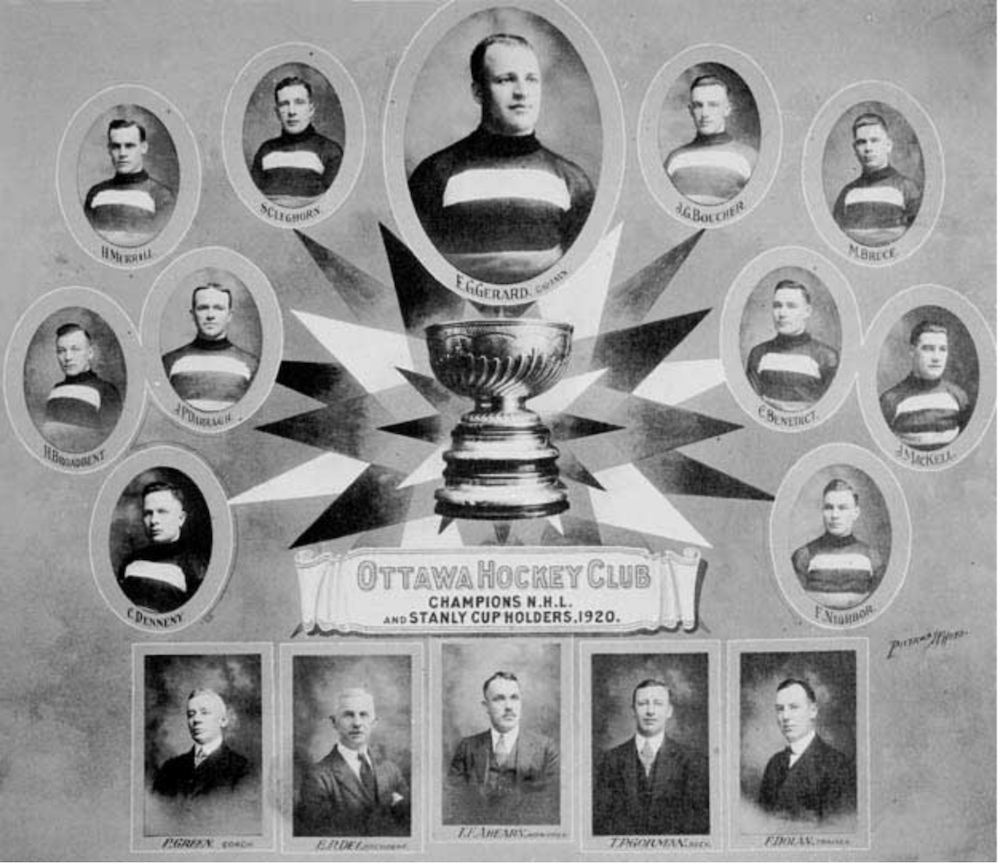
As championship teams from more and more leagues wished to challenge for the Stanley Cup, the trustees in charge of the trophy often had to arrange title games at any time during the hockey schedule. Sometimes the Stanley Cup was contested before the regular season started; sometimes right smack dab in the middle. For that reason, from 1893 to 1910, Stanley Cup games were played in December, January, February and March. Although no formal announcement seems to have been made, all Stanley Cup games since 1911 have always been played at the end of the hockey season.
Beginning in 1914, Stanley Cup play was limited to the National Hockey Association (forerunner of the NHL) and the Pacific Coast Hockey Association, whose championship teams would meet at the end of the season in a Stanley Cup Final often referred to as the World Series of Hockey. During this World Series era, all the games in a best-of-five series were scheduled for just one city. It could take six or seven days to travel across the continent by train, so the entire series was played in the eastern winner’s city one year and the western winner’s city the next.
If not for the Spanish Flu epidemic, the Stanley Cup Final of 1919 in Seattle would have stretched into April, but since the last game of that series wasn’t played, the first Stanley Cup game ever played in April took place one year later – 100 years ago today – on April 1, 1920. The teams that year were the NHL champion Ottawa Senators and the PCHA champion Seattle Metropolitans … yet the first Stanley Cup game to be played in April actually took place in Toronto.
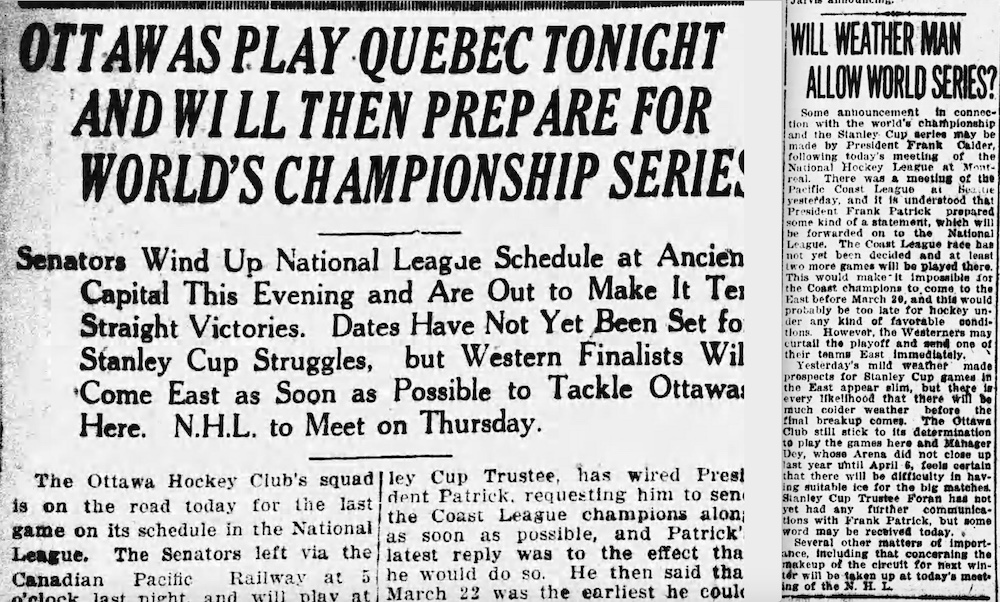
With the NHL newly expanded to four teams, and with the schedule extended to 24 games, the 1919–20 NHL season began on December 23, 1919, which was slightly later than the start of the first two seasons in league history and didn’t end until March 13, 1920 – which was also the latest date yet. In this era, the NHL used a split schedule, with a first-half champion and a second-half champion. The playoffs then pitted the first-half winner against the second-half winner to determine the league championship.
In 1920, Ottawa won the first half of the schedule in a tight race with the Montreal Canadiens. The Senators also won the second half, clinching it with a win over the Toronto St. Pats on March 3 with 10 days (and three games for each team) still left in the season. This meant there was no need for an NHL playoff and thoughts turned immediately to the Stanley Cup Final with the PCHA.

The Globe newspaper said yes on March 5, but no on March 9.
Out west, the PCHA had three teams in 1919–20: the Vancouver Millionaires, the Victoria Aristocrats, and Seattle. The PCHA played a full schedule, which was expanded to 22 games this season (each team played its two opponents 11 times at home and 11 times away) and ran from December 26 to March 10. Back in 1917-18, the PCHA had created what many consider to be the first modern-style playoff system in which the first-place team and second-place team would meet in a two-game, total-goal postseason series. In 1920, the second-place Millionaires won the first playoff game 3–1 on the road in Seattle on March 12, but the first-place Metropolitans stormed back for a 6–0 win in Vancouver three days later and took the series 7–3. The Mets left for Ottawa on March 16 and arrived in the Canadian capital on Sunday, March 21. The first game of the Stanley Cup Final was played the following evening.
Since clinching the NHL title nearly three weeks earlier, the Senators, their fans, and team executives (as well as NHL president Frank Calder, who would be in charge of the Stanley Cup series) had been keeping a nervous eye on the Ottawa weather. It had been unseasonably warm since the start of March, and was only getting warmer. There had been good, natural, ice available in Ottawa at the Arena on Laurier Avenue into the first week of April in 1919, but there were serious doubts the surface would hold up that long this time.
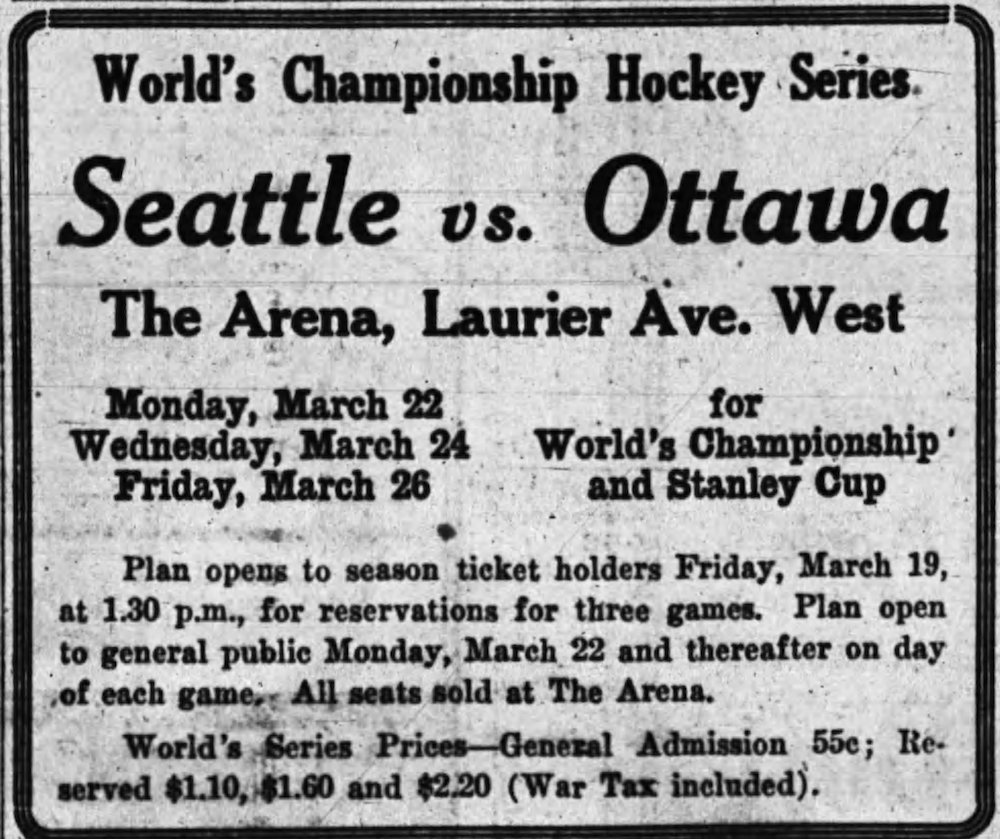
original dates of the first three games of the 1920 Stanley Cup Final.
There had been some talk in the newspapers about moving the 1920 Stanley Cup Final out West, where all three PCHA teams had artificial ice rinks. It’s unclear how serious those reports were. As early as March 5, there were stories about the NHL seeking to move the series to the Arena Gardens in Toronto — which also had artificial ice — but the finals of the Memorial Cup (junior hockey championship) and the Allan Cup (senior amateur championship) were already scheduled there in March. Since no firms plans could be made to move the Stanley Cup Final, it began in Ottawa despite the poor ice conditions.
The Senators hoped to play the entire series in front of their home fans, but the weather kept getting warmer … and the ice kept getting softer. With Seattle clearly hampered by the bad ice, the Senators won the first two games of the Stanley Cup Final. Game three was originally set for Friday night, March 26, but it was postponed until Saturday the 27th when the forecast called for slightly cooler temperatures. The delay would also allow Arena staff an extra day to remove the top layer of slush and – hopefully! – get down to a firmer surface below. However, if Seattle managed to stay alive (which they did, with a 3–1 victory that surprised most experts) it had already been announced that any remaining games in the series would be moved to Toronto.
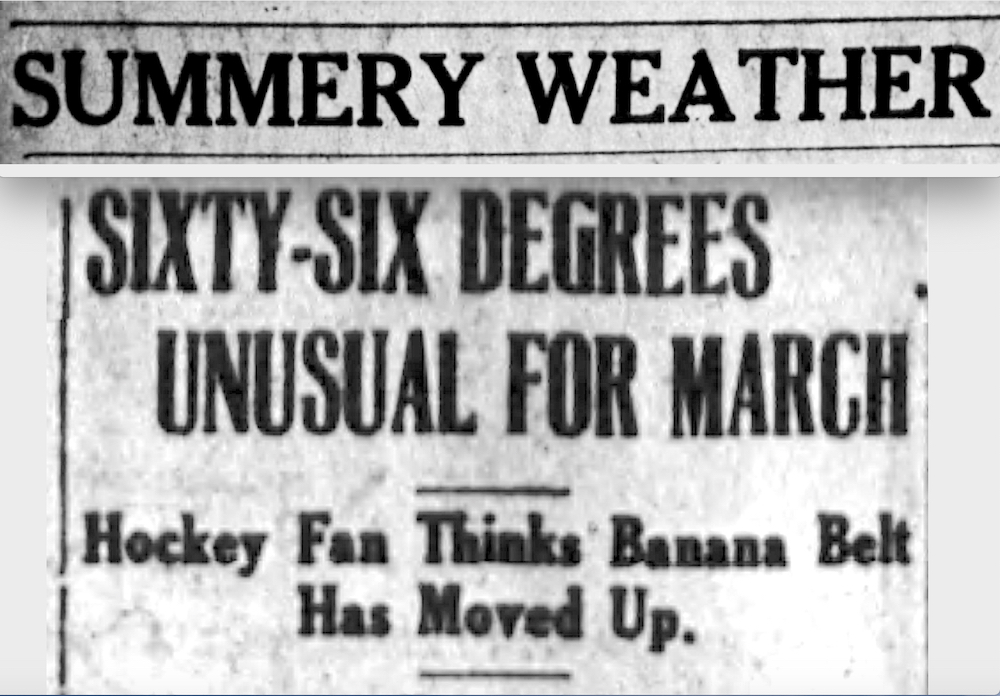
Playing on the hard, fast, artificial ice in Toronto, the Metropolitans scored a 5–2 victory in game four on March 30 to stay alive once again and extend the series into April. A Canadian Press report prior to the deciding contest on April 1 stated that, “the result of this important and soon-to-be-historic game is as uncertain as any game ever was in advance.” As further proof, the report noted that, “no line could be obtained tonight on the probable betting odds.”
The game certainly start out close, with the score tied 1–1 after two periods. Defenseman Bobby Rowe starred for Seattle, scoring the first goal midway through the first period and helping to keep Ottawa’s offense bottled up. But during the second period, Rowe delivered a check on Eddie Gerard and was accidentally cut just below the left eye by the blade of the Ottawa captain’s stick. Rowe went down, semi-conscious, in a pool of blood. He had to be helped off the ice and was rushed to St. Michael’s Hospital, where it took several stitches to close the wound.
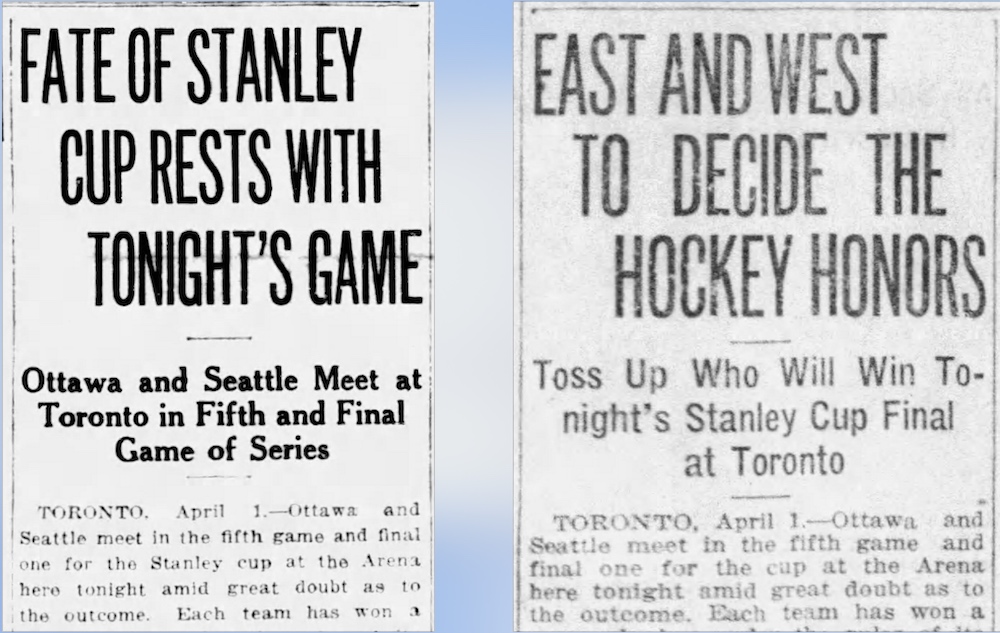
from the Edmonton Journal. The one on the right appeared in the Calgary Herald.
In an era when teams only carried a few substitute players, Seattle had to scramble. Winger Jim Riley was dropped back to take Rowe’s spot, leaving the team’s two other spares to fill in on the forward line. Five minutes into the third period, Jack Darragh went around Riley for a goal that put Ottawa up 2–1. Five minutes later, Eddie Gerard scored for the Senators. Ottawa went into a defensive shell after that, and Seattle cracked. The Mets were rarely able to get past center. Darragh scored again a few minutes later, and then he and Frank Nighbor added two quick goals late in the game as Ottawa pulled away for a 6–1 victory.
“I thought we had them until Rowe was hurt,” said Seattle star Frank Foyston, discussing the final game with local reporters after the team arrived home later in April, “but the Ottawas had saved themselves and skated us off our feet in the third period…. We were all sorry to lose, but we were beaten by a wonderful team. They’re a credit to the game.”

“I noticed that you didn’t get the cold spell until the month of April,” wrote Mets coach Pete Muldoon in a letter to Ottawa hockey executives from his Seattle office. “Why don’t you get on better terms with the weather man. He’s about the only chap you fellows didn’t have pulling with you.” But even Muldoon had admitted on April 1 that, “the better team won tonight. It was a great series and we have no kick to make.” Still, the Seattle players believed their chances to win would have been better if the entire series had been played on better ice.
By 1927, the NHL was the only league left in competition for the Stanley Cup … and all its teams by then had artificial ice rinks. As the league – and its schedule – grew larger over the years, the first Stanley Cup game in May was played in 1965. The first game in June was played in 1992. Will this year mark the first time that Stanley Cup games are played in July and August? I guess we’ll have to wait and see…
Always an engaging read!!
Thanks Eric…a fascinating story.
Keep well and keep writing.
So nice to read something other than about the Coronavirus.
Thanks so much for sharing your knowledge.
Will Ottawa play Seattle again for the Cup in my lifetime? Is the only way a final game will be seen in Toronto is if it is too warm elsewhere? Will defence determine a winner? Will there be a Stanley Cup in 2020?
Actually I thought Lord Stanley donated a cup for the best Amateur hockey clubs? Or is it now Lord Bettman’s cup? Millions earned by players from billionaire owners does not meet the criteria.
Maybe we need to bring back The St. Patrick’s or the Arenas?
Once again a vaccinating article to remind us that we are a hockey nation, starved for more games. Congrats!
Given the world we are in, anything is possible.
You are a hockey encyclopedia.
Keep safe .
Marilyn Henighan
Eric,
You sure unfolded a lot of info which is all new to me.
Thanks so much. No Foolin’
Glen
Totally cool story (no pun intended!)
I hope that Life as we know it returns to ‘normal’ soon….it is odd w/out Sports….I hope you are well & staying safe Eric. Keep on writing; we will keep on reading for sure…..
Sherri-Ellen & BellaDharma